MGT202 - Leadership: Reflective Essay on Organisational Learning
VerifiedAdded on 2023/06/14
|8
|2148
|440
Essay
AI Summary
This essay delves into the multifaceted role of a leader within an organization, examining the concepts of 'knowing the way,' 'going the way,' and 'showing the way' through the framework of organizational learning theories. It emphasizes the leader's responsibility in creating a shared vision, guiding organizational members towards goal completion, and fostering an environment of continuous learning and adaptation. The essay highlights the importance of a leader's knowledge, initiative, and ability to inspire and guide employees, drawing parallels to roles such as architect, steward, and teacher. It also discusses the leader's role as a representative of the firm, a solicitor of support, and a friend to employees, emphasizing the need for dynamic leadership that embraces learning and growth. The essay includes practical examples illustrating how effective leadership can transform challenging situations and drive organizational success. Desklib offers a wealth of similar resources for students.
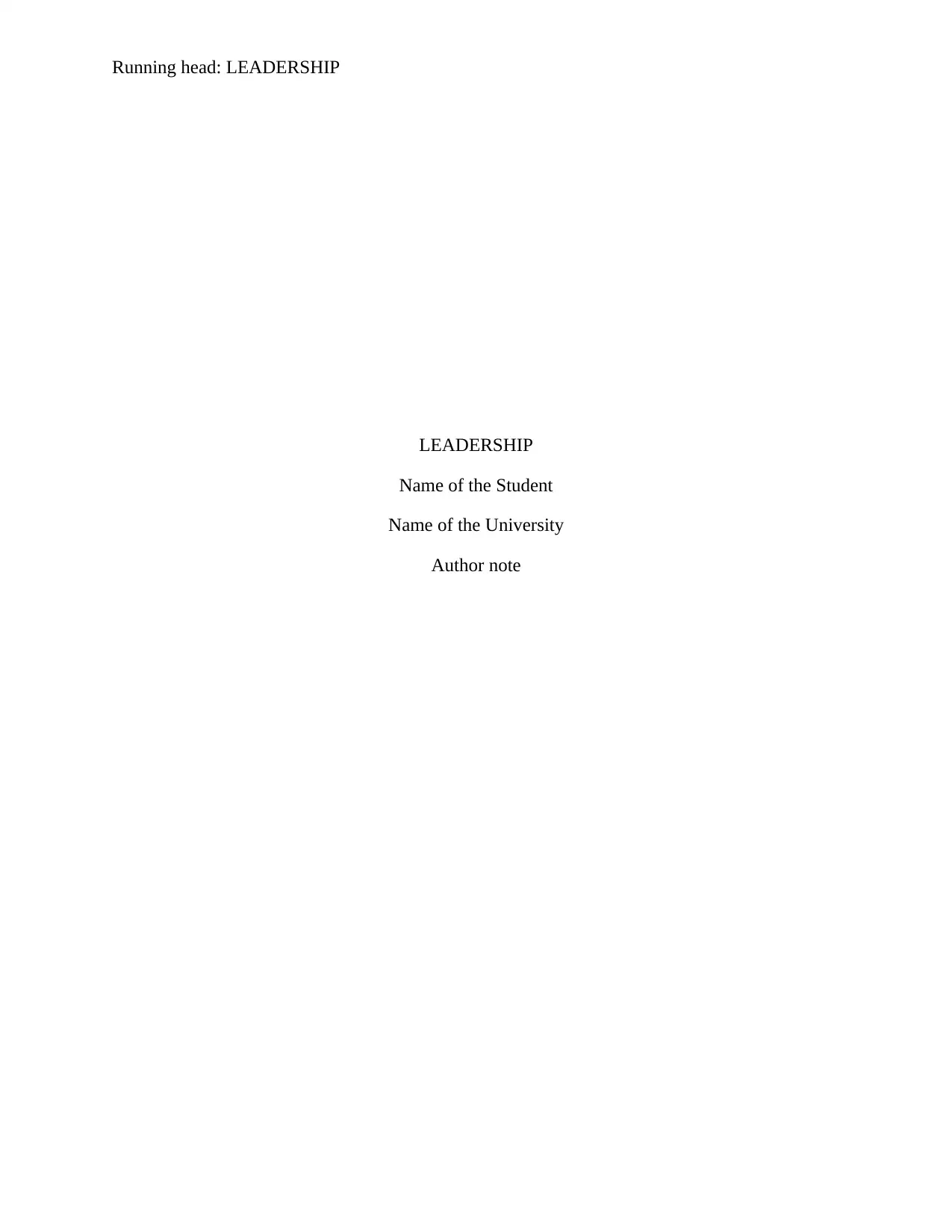
Running head: LEADERSHIP
LEADERSHIP
Name of the Student
Name of the University
Author note
LEADERSHIP
Name of the Student
Name of the University
Author note
Paraphrase This Document
Need a fresh take? Get an instant paraphrase of this document with our AI Paraphraser
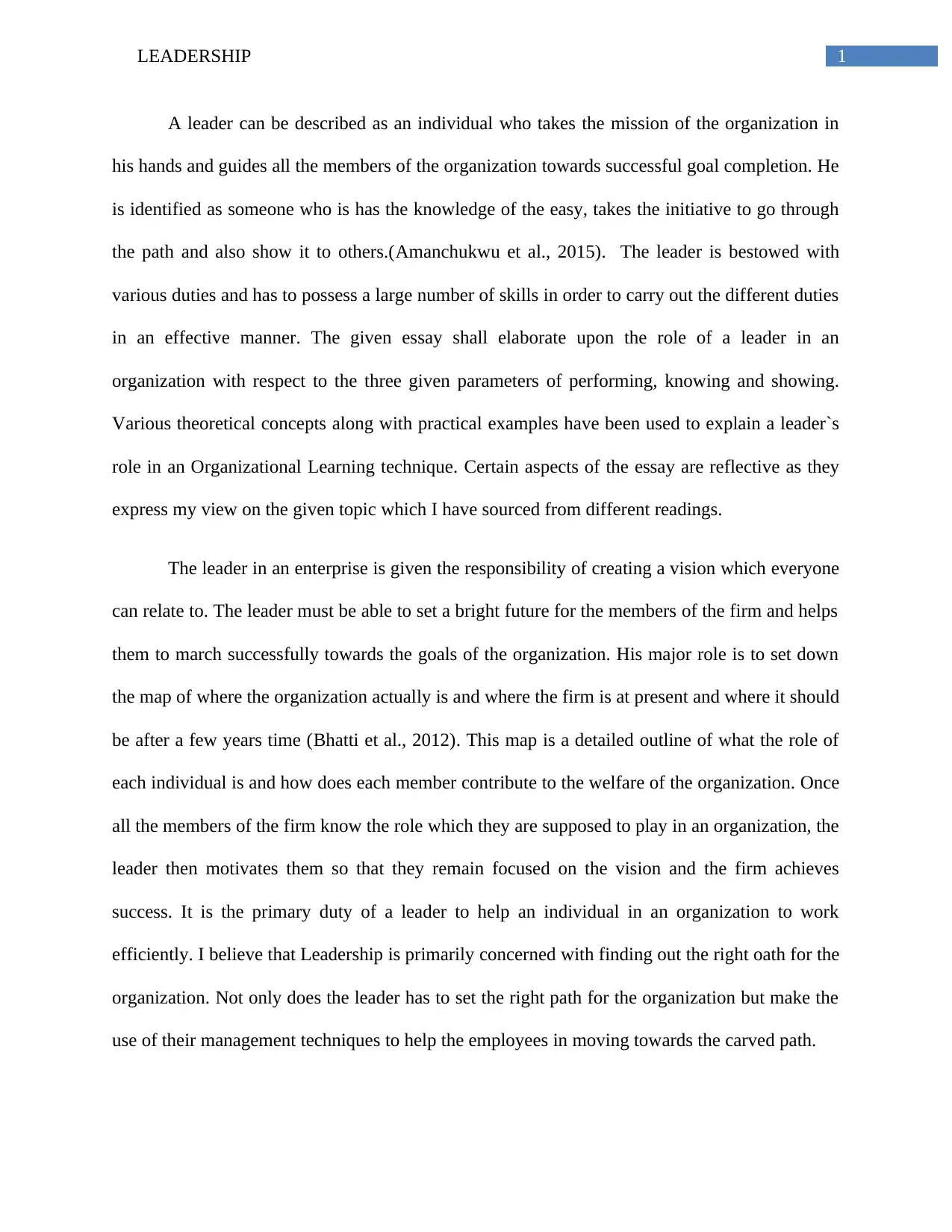
1LEADERSHIP
A leader can be described as an individual who takes the mission of the organization in
his hands and guides all the members of the organization towards successful goal completion. He
is identified as someone who is has the knowledge of the easy, takes the initiative to go through
the path and also show it to others.(Amanchukwu et al., 2015). The leader is bestowed with
various duties and has to possess a large number of skills in order to carry out the different duties
in an effective manner. The given essay shall elaborate upon the role of a leader in an
organization with respect to the three given parameters of performing, knowing and showing.
Various theoretical concepts along with practical examples have been used to explain a leader`s
role in an Organizational Learning technique. Certain aspects of the essay are reflective as they
express my view on the given topic which I have sourced from different readings.
The leader in an enterprise is given the responsibility of creating a vision which everyone
can relate to. The leader must be able to set a bright future for the members of the firm and helps
them to march successfully towards the goals of the organization. His major role is to set down
the map of where the organization actually is and where the firm is at present and where it should
be after a few years time (Bhatti et al., 2012). This map is a detailed outline of what the role of
each individual is and how does each member contribute to the welfare of the organization. Once
all the members of the firm know the role which they are supposed to play in an organization, the
leader then motivates them so that they remain focused on the vision and the firm achieves
success. It is the primary duty of a leader to help an individual in an organization to work
efficiently. I believe that Leadership is primarily concerned with finding out the right oath for the
organization. Not only does the leader has to set the right path for the organization but make the
use of their management techniques to help the employees in moving towards the carved path.
A leader can be described as an individual who takes the mission of the organization in
his hands and guides all the members of the organization towards successful goal completion. He
is identified as someone who is has the knowledge of the easy, takes the initiative to go through
the path and also show it to others.(Amanchukwu et al., 2015). The leader is bestowed with
various duties and has to possess a large number of skills in order to carry out the different duties
in an effective manner. The given essay shall elaborate upon the role of a leader in an
organization with respect to the three given parameters of performing, knowing and showing.
Various theoretical concepts along with practical examples have been used to explain a leader`s
role in an Organizational Learning technique. Certain aspects of the essay are reflective as they
express my view on the given topic which I have sourced from different readings.
The leader in an enterprise is given the responsibility of creating a vision which everyone
can relate to. The leader must be able to set a bright future for the members of the firm and helps
them to march successfully towards the goals of the organization. His major role is to set down
the map of where the organization actually is and where the firm is at present and where it should
be after a few years time (Bhatti et al., 2012). This map is a detailed outline of what the role of
each individual is and how does each member contribute to the welfare of the organization. Once
all the members of the firm know the role which they are supposed to play in an organization, the
leader then motivates them so that they remain focused on the vision and the firm achieves
success. It is the primary duty of a leader to help an individual in an organization to work
efficiently. I believe that Leadership is primarily concerned with finding out the right oath for the
organization. Not only does the leader has to set the right path for the organization but make the
use of their management techniques to help the employees in moving towards the carved path.
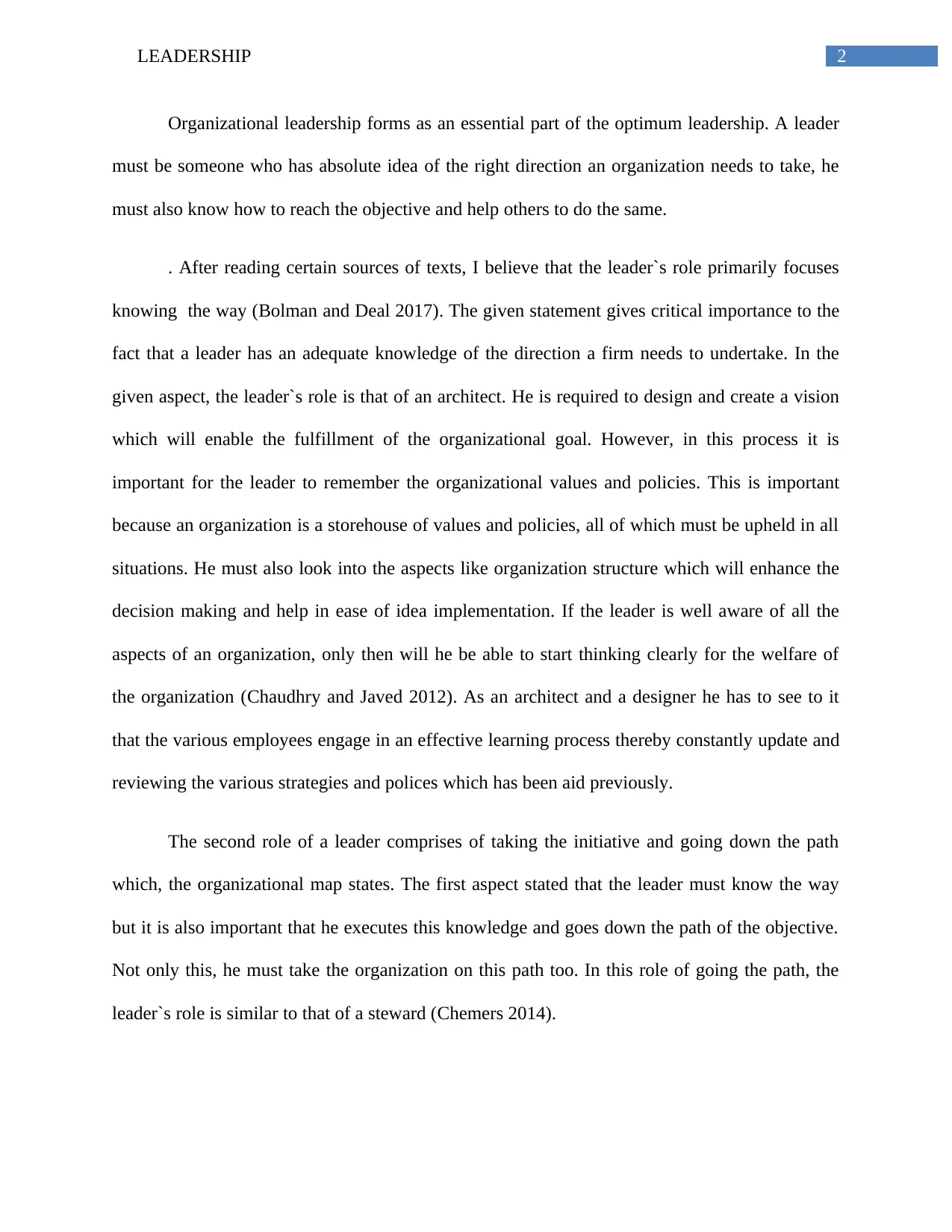
2LEADERSHIP
Organizational leadership forms as an essential part of the optimum leadership. A leader
must be someone who has absolute idea of the right direction an organization needs to take, he
must also know how to reach the objective and help others to do the same.
. After reading certain sources of texts, I believe that the leader`s role primarily focuses
knowing the way (Bolman and Deal 2017). The given statement gives critical importance to the
fact that a leader has an adequate knowledge of the direction a firm needs to undertake. In the
given aspect, the leader`s role is that of an architect. He is required to design and create a vision
which will enable the fulfillment of the organizational goal. However, in this process it is
important for the leader to remember the organizational values and policies. This is important
because an organization is a storehouse of values and policies, all of which must be upheld in all
situations. He must also look into the aspects like organization structure which will enhance the
decision making and help in ease of idea implementation. If the leader is well aware of all the
aspects of an organization, only then will he be able to start thinking clearly for the welfare of
the organization (Chaudhry and Javed 2012). As an architect and a designer he has to see to it
that the various employees engage in an effective learning process thereby constantly update and
reviewing the various strategies and polices which has been aid previously.
The second role of a leader comprises of taking the initiative and going down the path
which, the organizational map states. The first aspect stated that the leader must know the way
but it is also important that he executes this knowledge and goes down the path of the objective.
Not only this, he must take the organization on this path too. In this role of going the path, the
leader`s role is similar to that of a steward (Chemers 2014).
Organizational leadership forms as an essential part of the optimum leadership. A leader
must be someone who has absolute idea of the right direction an organization needs to take, he
must also know how to reach the objective and help others to do the same.
. After reading certain sources of texts, I believe that the leader`s role primarily focuses
knowing the way (Bolman and Deal 2017). The given statement gives critical importance to the
fact that a leader has an adequate knowledge of the direction a firm needs to undertake. In the
given aspect, the leader`s role is that of an architect. He is required to design and create a vision
which will enable the fulfillment of the organizational goal. However, in this process it is
important for the leader to remember the organizational values and policies. This is important
because an organization is a storehouse of values and policies, all of which must be upheld in all
situations. He must also look into the aspects like organization structure which will enhance the
decision making and help in ease of idea implementation. If the leader is well aware of all the
aspects of an organization, only then will he be able to start thinking clearly for the welfare of
the organization (Chaudhry and Javed 2012). As an architect and a designer he has to see to it
that the various employees engage in an effective learning process thereby constantly update and
reviewing the various strategies and polices which has been aid previously.
The second role of a leader comprises of taking the initiative and going down the path
which, the organizational map states. The first aspect stated that the leader must know the way
but it is also important that he executes this knowledge and goes down the path of the objective.
Not only this, he must take the organization on this path too. In this role of going the path, the
leader`s role is similar to that of a steward (Chemers 2014).
⊘ This is a preview!⊘
Do you want full access?
Subscribe today to unlock all pages.

Trusted by 1+ million students worldwide
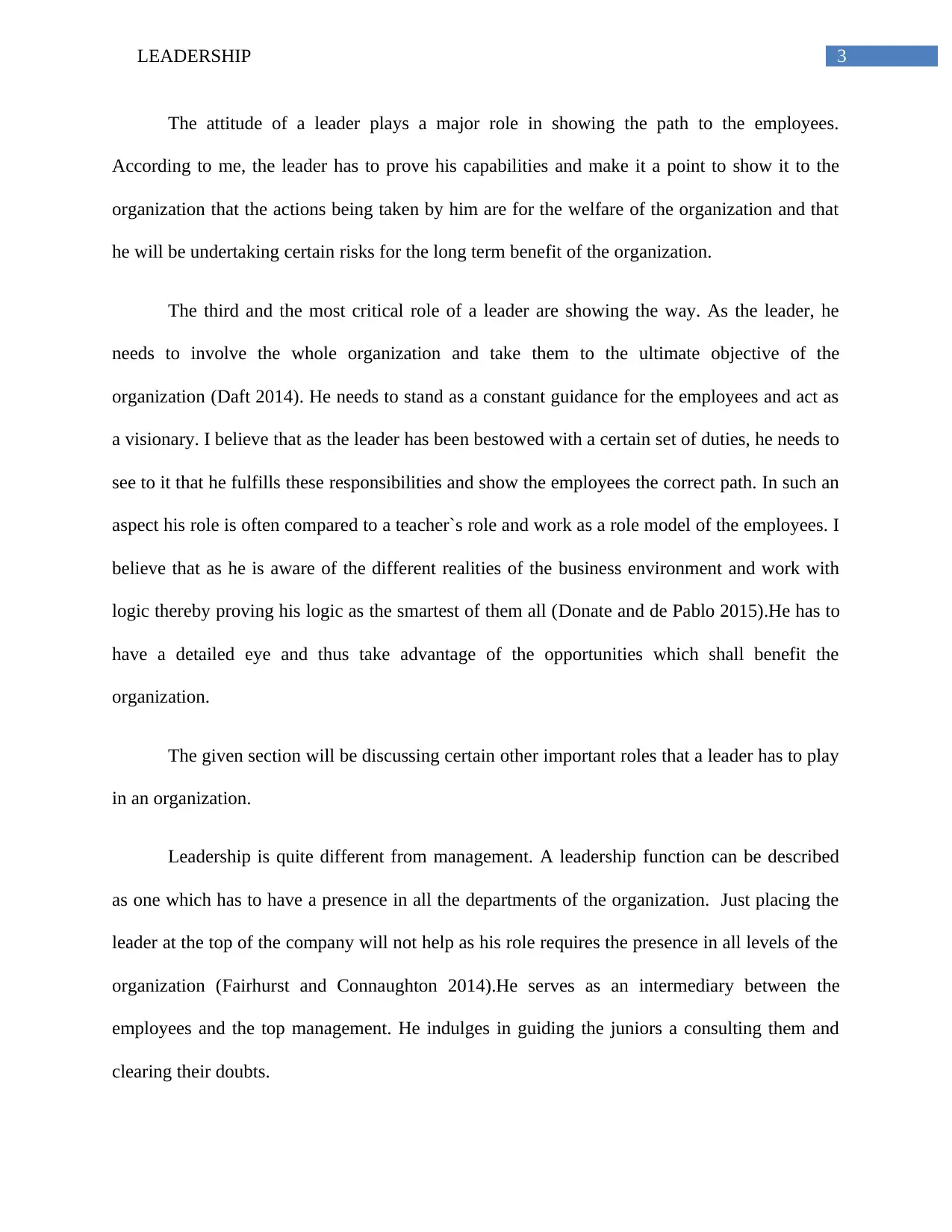
3LEADERSHIP
The attitude of a leader plays a major role in showing the path to the employees.
According to me, the leader has to prove his capabilities and make it a point to show it to the
organization that the actions being taken by him are for the welfare of the organization and that
he will be undertaking certain risks for the long term benefit of the organization.
The third and the most critical role of a leader are showing the way. As the leader, he
needs to involve the whole organization and take them to the ultimate objective of the
organization (Daft 2014). He needs to stand as a constant guidance for the employees and act as
a visionary. I believe that as the leader has been bestowed with a certain set of duties, he needs to
see to it that he fulfills these responsibilities and show the employees the correct path. In such an
aspect his role is often compared to a teacher`s role and work as a role model of the employees. I
believe that as he is aware of the different realities of the business environment and work with
logic thereby proving his logic as the smartest of them all (Donate and de Pablo 2015).He has to
have a detailed eye and thus take advantage of the opportunities which shall benefit the
organization.
The given section will be discussing certain other important roles that a leader has to play
in an organization.
Leadership is quite different from management. A leadership function can be described
as one which has to have a presence in all the departments of the organization. Just placing the
leader at the top of the company will not help as his role requires the presence in all levels of the
organization (Fairhurst and Connaughton 2014).He serves as an intermediary between the
employees and the top management. He indulges in guiding the juniors a consulting them and
clearing their doubts.
The attitude of a leader plays a major role in showing the path to the employees.
According to me, the leader has to prove his capabilities and make it a point to show it to the
organization that the actions being taken by him are for the welfare of the organization and that
he will be undertaking certain risks for the long term benefit of the organization.
The third and the most critical role of a leader are showing the way. As the leader, he
needs to involve the whole organization and take them to the ultimate objective of the
organization (Daft 2014). He needs to stand as a constant guidance for the employees and act as
a visionary. I believe that as the leader has been bestowed with a certain set of duties, he needs to
see to it that he fulfills these responsibilities and show the employees the correct path. In such an
aspect his role is often compared to a teacher`s role and work as a role model of the employees. I
believe that as he is aware of the different realities of the business environment and work with
logic thereby proving his logic as the smartest of them all (Donate and de Pablo 2015).He has to
have a detailed eye and thus take advantage of the opportunities which shall benefit the
organization.
The given section will be discussing certain other important roles that a leader has to play
in an organization.
Leadership is quite different from management. A leadership function can be described
as one which has to have a presence in all the departments of the organization. Just placing the
leader at the top of the company will not help as his role requires the presence in all levels of the
organization (Fairhurst and Connaughton 2014).He serves as an intermediary between the
employees and the top management. He indulges in guiding the juniors a consulting them and
clearing their doubts.
Paraphrase This Document
Need a fresh take? Get an instant paraphrase of this document with our AI Paraphraser
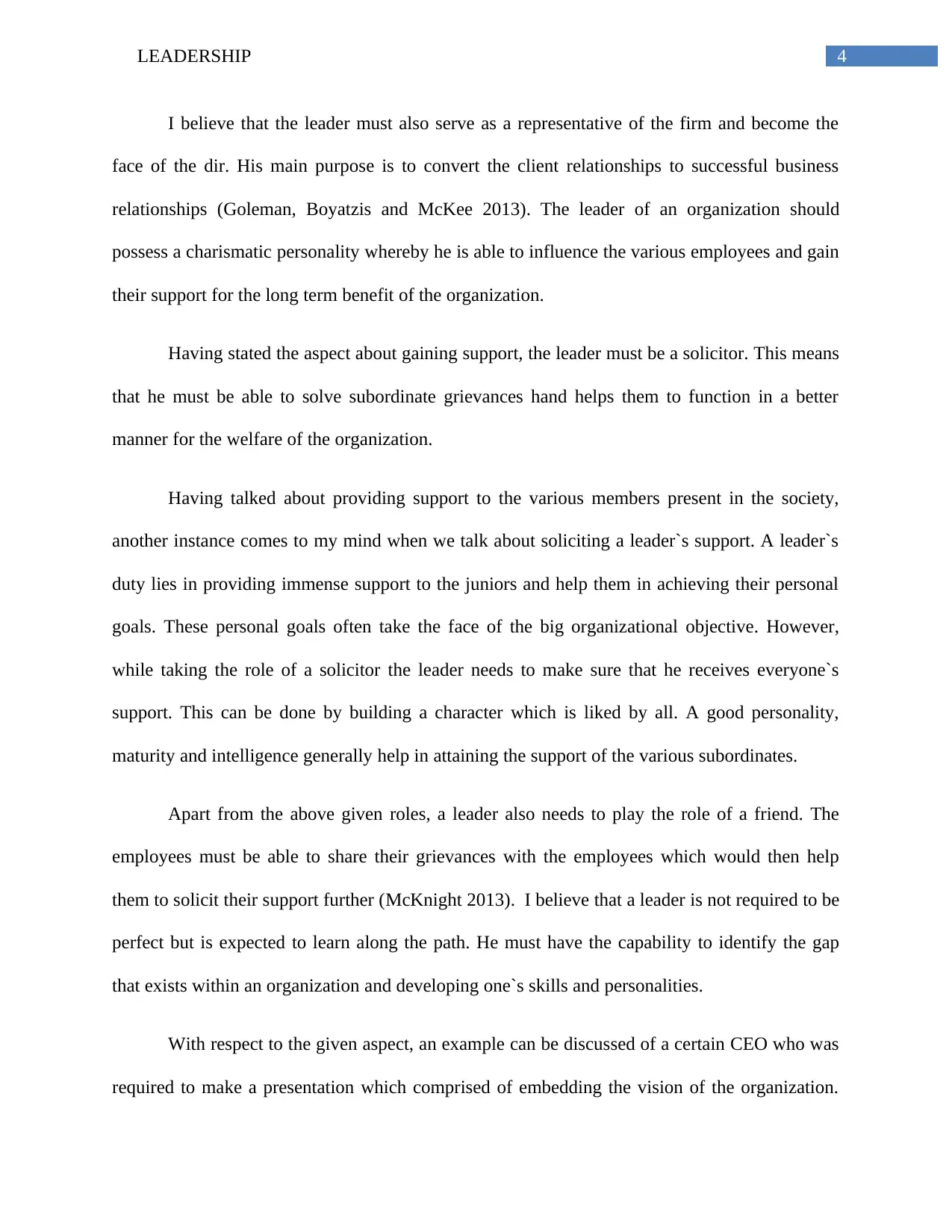
4LEADERSHIP
I believe that the leader must also serve as a representative of the firm and become the
face of the dir. His main purpose is to convert the client relationships to successful business
relationships (Goleman, Boyatzis and McKee 2013). The leader of an organization should
possess a charismatic personality whereby he is able to influence the various employees and gain
their support for the long term benefit of the organization.
Having stated the aspect about gaining support, the leader must be a solicitor. This means
that he must be able to solve subordinate grievances hand helps them to function in a better
manner for the welfare of the organization.
Having talked about providing support to the various members present in the society,
another instance comes to my mind when we talk about soliciting a leader`s support. A leader`s
duty lies in providing immense support to the juniors and help them in achieving their personal
goals. These personal goals often take the face of the big organizational objective. However,
while taking the role of a solicitor the leader needs to make sure that he receives everyone`s
support. This can be done by building a character which is liked by all. A good personality,
maturity and intelligence generally help in attaining the support of the various subordinates.
Apart from the above given roles, a leader also needs to play the role of a friend. The
employees must be able to share their grievances with the employees which would then help
them to solicit their support further (McKnight 2013). I believe that a leader is not required to be
perfect but is expected to learn along the path. He must have the capability to identify the gap
that exists within an organization and developing one`s skills and personalities.
With respect to the given aspect, an example can be discussed of a certain CEO who was
required to make a presentation which comprised of embedding the vision of the organization.
I believe that the leader must also serve as a representative of the firm and become the
face of the dir. His main purpose is to convert the client relationships to successful business
relationships (Goleman, Boyatzis and McKee 2013). The leader of an organization should
possess a charismatic personality whereby he is able to influence the various employees and gain
their support for the long term benefit of the organization.
Having stated the aspect about gaining support, the leader must be a solicitor. This means
that he must be able to solve subordinate grievances hand helps them to function in a better
manner for the welfare of the organization.
Having talked about providing support to the various members present in the society,
another instance comes to my mind when we talk about soliciting a leader`s support. A leader`s
duty lies in providing immense support to the juniors and help them in achieving their personal
goals. These personal goals often take the face of the big organizational objective. However,
while taking the role of a solicitor the leader needs to make sure that he receives everyone`s
support. This can be done by building a character which is liked by all. A good personality,
maturity and intelligence generally help in attaining the support of the various subordinates.
Apart from the above given roles, a leader also needs to play the role of a friend. The
employees must be able to share their grievances with the employees which would then help
them to solicit their support further (McKnight 2013). I believe that a leader is not required to be
perfect but is expected to learn along the path. He must have the capability to identify the gap
that exists within an organization and developing one`s skills and personalities.
With respect to the given aspect, an example can be discussed of a certain CEO who was
required to make a presentation which comprised of embedding the vision of the organization.
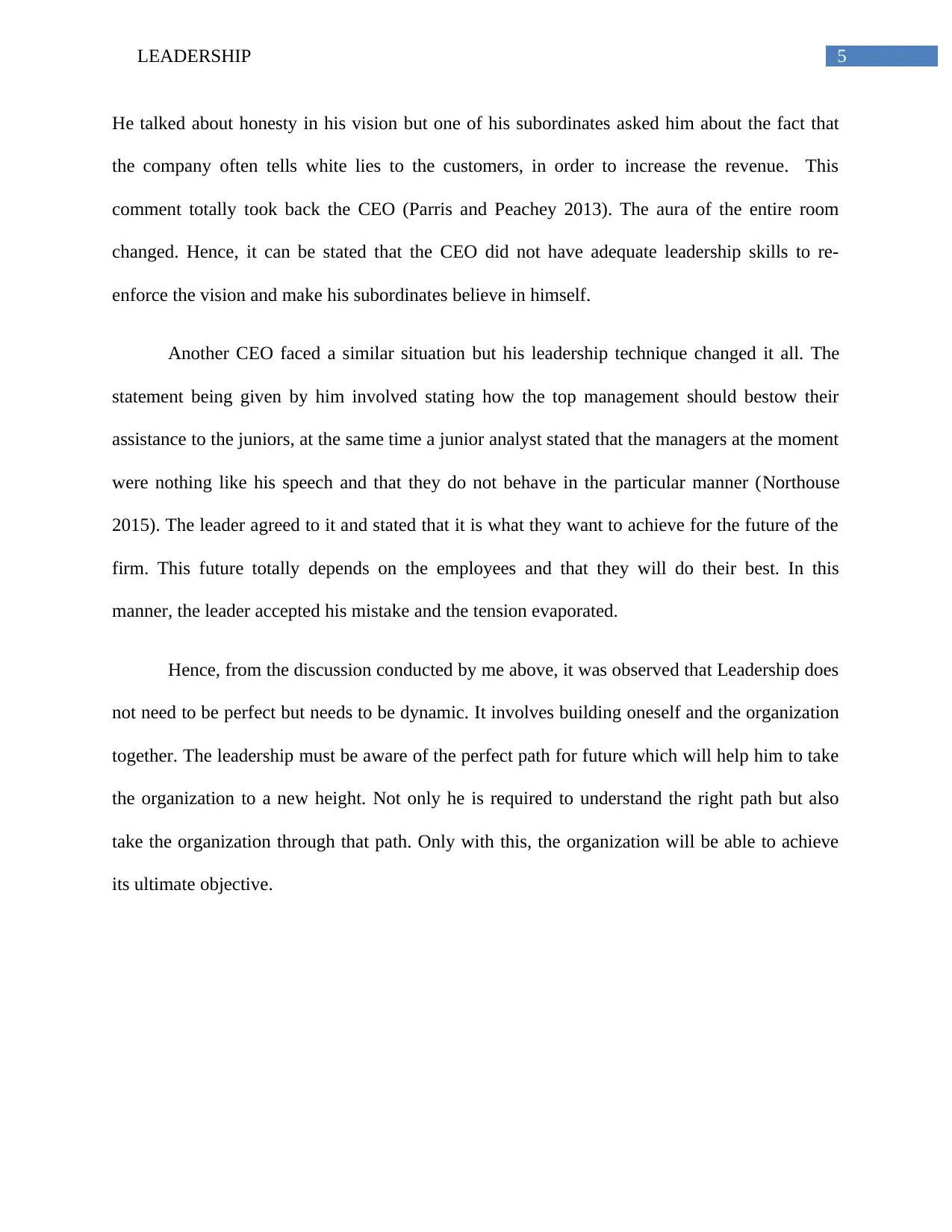
5LEADERSHIP
He talked about honesty in his vision but one of his subordinates asked him about the fact that
the company often tells white lies to the customers, in order to increase the revenue. This
comment totally took back the CEO (Parris and Peachey 2013). The aura of the entire room
changed. Hence, it can be stated that the CEO did not have adequate leadership skills to re-
enforce the vision and make his subordinates believe in himself.
Another CEO faced a similar situation but his leadership technique changed it all. The
statement being given by him involved stating how the top management should bestow their
assistance to the juniors, at the same time a junior analyst stated that the managers at the moment
were nothing like his speech and that they do not behave in the particular manner (Northouse
2015). The leader agreed to it and stated that it is what they want to achieve for the future of the
firm. This future totally depends on the employees and that they will do their best. In this
manner, the leader accepted his mistake and the tension evaporated.
Hence, from the discussion conducted by me above, it was observed that Leadership does
not need to be perfect but needs to be dynamic. It involves building oneself and the organization
together. The leadership must be aware of the perfect path for future which will help him to take
the organization to a new height. Not only he is required to understand the right path but also
take the organization through that path. Only with this, the organization will be able to achieve
its ultimate objective.
He talked about honesty in his vision but one of his subordinates asked him about the fact that
the company often tells white lies to the customers, in order to increase the revenue. This
comment totally took back the CEO (Parris and Peachey 2013). The aura of the entire room
changed. Hence, it can be stated that the CEO did not have adequate leadership skills to re-
enforce the vision and make his subordinates believe in himself.
Another CEO faced a similar situation but his leadership technique changed it all. The
statement being given by him involved stating how the top management should bestow their
assistance to the juniors, at the same time a junior analyst stated that the managers at the moment
were nothing like his speech and that they do not behave in the particular manner (Northouse
2015). The leader agreed to it and stated that it is what they want to achieve for the future of the
firm. This future totally depends on the employees and that they will do their best. In this
manner, the leader accepted his mistake and the tension evaporated.
Hence, from the discussion conducted by me above, it was observed that Leadership does
not need to be perfect but needs to be dynamic. It involves building oneself and the organization
together. The leadership must be aware of the perfect path for future which will help him to take
the organization to a new height. Not only he is required to understand the right path but also
take the organization through that path. Only with this, the organization will be able to achieve
its ultimate objective.
⊘ This is a preview!⊘
Do you want full access?
Subscribe today to unlock all pages.

Trusted by 1+ million students worldwide
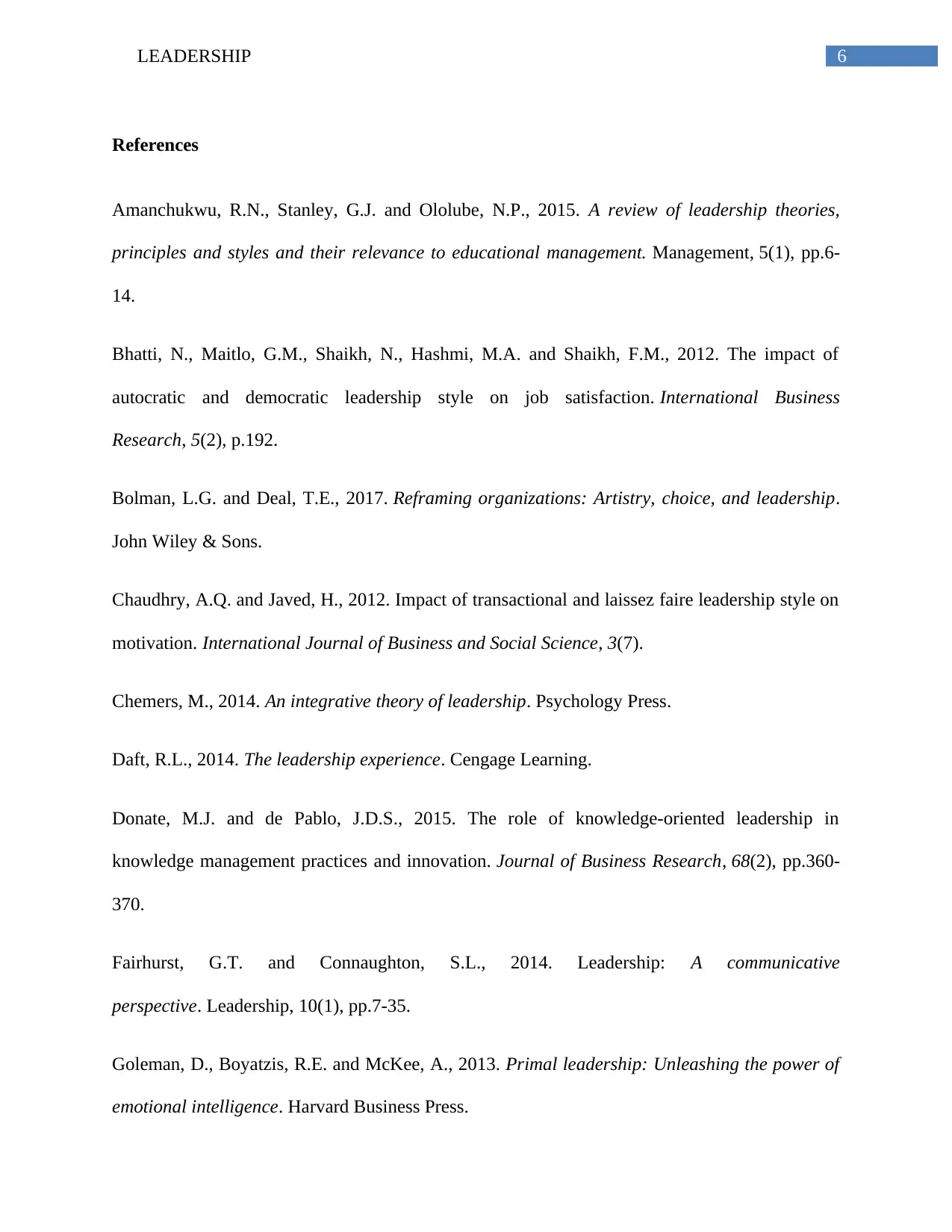
6LEADERSHIP
References
Amanchukwu, R.N., Stanley, G.J. and Ololube, N.P., 2015. A review of leadership theories,
principles and styles and their relevance to educational management. Management, 5(1), pp.6-
14.
Bhatti, N., Maitlo, G.M., Shaikh, N., Hashmi, M.A. and Shaikh, F.M., 2012. The impact of
autocratic and democratic leadership style on job satisfaction. International Business
Research, 5(2), p.192.
Bolman, L.G. and Deal, T.E., 2017. Reframing organizations: Artistry, choice, and leadership.
John Wiley & Sons.
Chaudhry, A.Q. and Javed, H., 2012. Impact of transactional and laissez faire leadership style on
motivation. International Journal of Business and Social Science, 3(7).
Chemers, M., 2014. An integrative theory of leadership. Psychology Press.
Daft, R.L., 2014. The leadership experience. Cengage Learning.
Donate, M.J. and de Pablo, J.D.S., 2015. The role of knowledge-oriented leadership in
knowledge management practices and innovation. Journal of Business Research, 68(2), pp.360-
370.
Fairhurst, G.T. and Connaughton, S.L., 2014. Leadership: A communicative
perspective. Leadership, 10(1), pp.7-35.
Goleman, D., Boyatzis, R.E. and McKee, A., 2013. Primal leadership: Unleashing the power of
emotional intelligence. Harvard Business Press.
References
Amanchukwu, R.N., Stanley, G.J. and Ololube, N.P., 2015. A review of leadership theories,
principles and styles and their relevance to educational management. Management, 5(1), pp.6-
14.
Bhatti, N., Maitlo, G.M., Shaikh, N., Hashmi, M.A. and Shaikh, F.M., 2012. The impact of
autocratic and democratic leadership style on job satisfaction. International Business
Research, 5(2), p.192.
Bolman, L.G. and Deal, T.E., 2017. Reframing organizations: Artistry, choice, and leadership.
John Wiley & Sons.
Chaudhry, A.Q. and Javed, H., 2012. Impact of transactional and laissez faire leadership style on
motivation. International Journal of Business and Social Science, 3(7).
Chemers, M., 2014. An integrative theory of leadership. Psychology Press.
Daft, R.L., 2014. The leadership experience. Cengage Learning.
Donate, M.J. and de Pablo, J.D.S., 2015. The role of knowledge-oriented leadership in
knowledge management practices and innovation. Journal of Business Research, 68(2), pp.360-
370.
Fairhurst, G.T. and Connaughton, S.L., 2014. Leadership: A communicative
perspective. Leadership, 10(1), pp.7-35.
Goleman, D., Boyatzis, R.E. and McKee, A., 2013. Primal leadership: Unleashing the power of
emotional intelligence. Harvard Business Press.
Paraphrase This Document
Need a fresh take? Get an instant paraphrase of this document with our AI Paraphraser
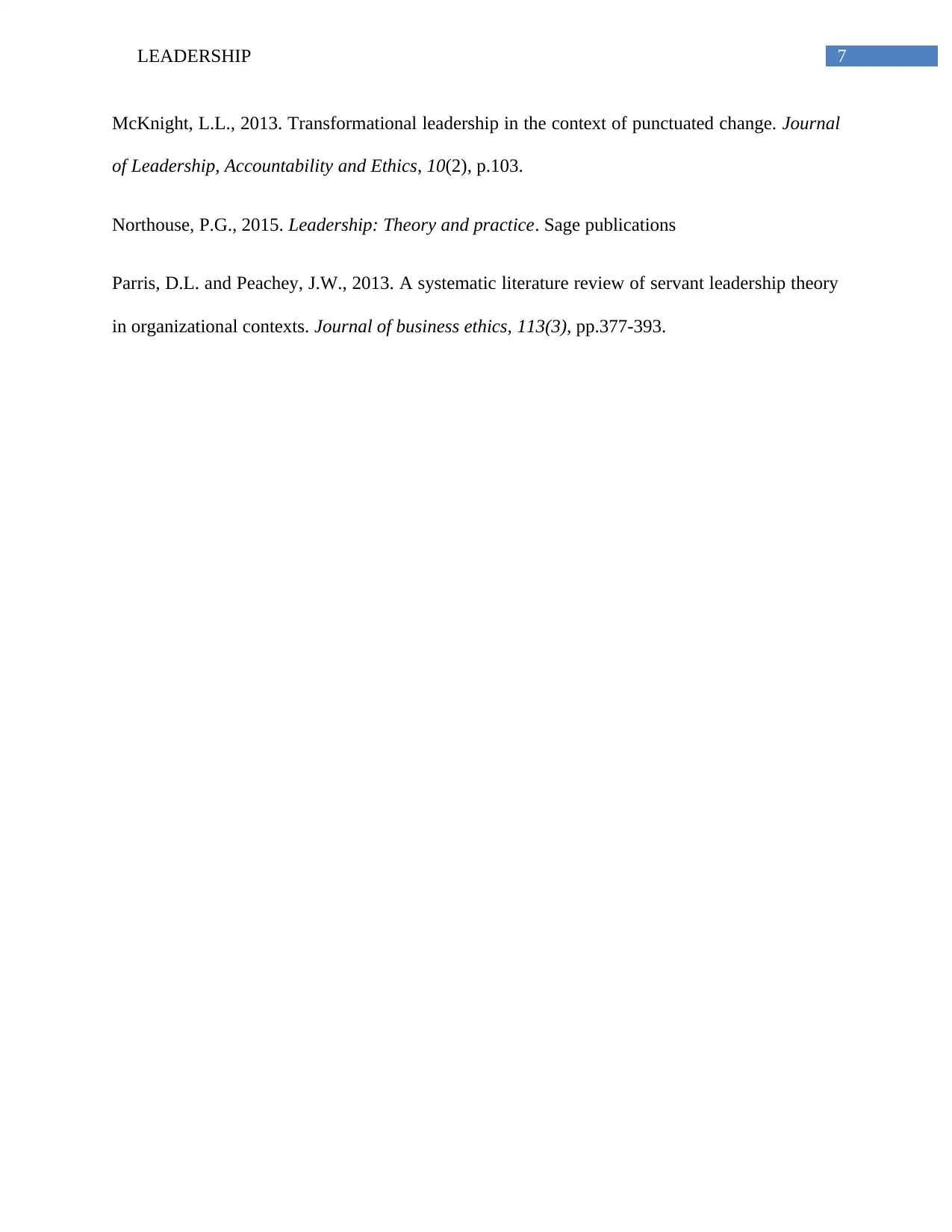
7LEADERSHIP
McKnight, L.L., 2013. Transformational leadership in the context of punctuated change. Journal
of Leadership, Accountability and Ethics, 10(2), p.103.
Northouse, P.G., 2015. Leadership: Theory and practice. Sage publications
Parris, D.L. and Peachey, J.W., 2013. A systematic literature review of servant leadership theory
in organizational contexts. Journal of business ethics, 113(3), pp.377-393.
McKnight, L.L., 2013. Transformational leadership in the context of punctuated change. Journal
of Leadership, Accountability and Ethics, 10(2), p.103.
Northouse, P.G., 2015. Leadership: Theory and practice. Sage publications
Parris, D.L. and Peachey, J.W., 2013. A systematic literature review of servant leadership theory
in organizational contexts. Journal of business ethics, 113(3), pp.377-393.
1 out of 8
Related Documents
Your All-in-One AI-Powered Toolkit for Academic Success.
+13062052269
info@desklib.com
Available 24*7 on WhatsApp / Email
![[object Object]](/_next/static/media/star-bottom.7253800d.svg)
Unlock your academic potential
Copyright © 2020–2025 A2Z Services. All Rights Reserved. Developed and managed by ZUCOL.





